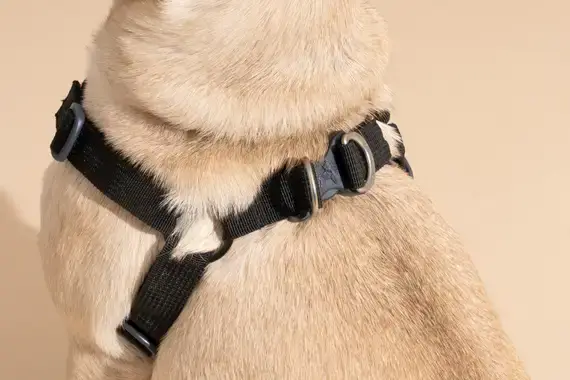Table of Contents
Table of Contents
- Introduction to Side Ring Dog Harnesses
- Benefits of Using a Side Ring Dog Harness
- How a Side Ring Harness Enhances Walks
- Selecting the Right Side Ring Harness
- Training Your Dog with a Side Ring Harness
- Expert Opinions on Side Ring Harnesses
- Final Thoughts on Side Ring Dog Harnesses
Introduction to Side Ring Dog Harnesses
Walking your dog is one of life’s simple pleasures, but it can also be challenging without the right equipment. That’s where a side ring dog harness comes into play. These harnesses are designed to keep your dog safe and ensure the walk is enjoyable for you and your furry friend. A side-ring dog harness typically features a leash attachment point on the side. This design offers several advantages, including better control and a reduced risk of choking compared to standard collars. It helps guide your dog in the desired direction without causing discomfort or harm, making your walks smoother and more enjoyable.
Benefits of Using a Side Ring Dog Harness
Side ring dog harnesses offer a multitude of benefits. They distribute pressure more evenly than traditional collars, reducing the risk of injuries to your dog’s neck and spine. Additionally, research by Canine Journal suggests that dogs are less likely to pull when using a side ring harness, making walks more pleasant for both parties. The even distribution of force prevents concentrated pressure on any part of your dog’s body, which is especially important for breeds prone to respiratory issues or neck injuries.
How a Side Ring Harness Enhances Walks
A side ring harness helps guide your dog from the side, significantly improving their walking behavior. This type of harness offers greater control, making it easier to lead and manage your dog. As noted in the ASPCA’s guidelines on general dog care, proper gear is essential for training and ensuring that walks are safe and enjoyable. By positioning the leash attachment on the side, the harness naturally encourages your dog to walk calmly beside you, reducing the tendency to pull or veer off course.
Moreover, side ring harnesses can help in training sessions by providing a gentle yet effective way to correct your dog’s movements. This can be particularly helpful for dogs that are easily distracted or reactive to their environment. With consistent use and positive reinforcement, a side ring harness can transform chaotic walks into peaceful strolls.
Selecting the Right Side Ring Harness
The right-side ring harness for your dog should consider factors like size, material, and adjustability. Adjustable straps are common, but measuring your dog’s girth and chest is crucial to avoid discomfort. Choose a harness made from durable, breathable fabric like nylon or neoprene for strength and comfort. Nylon is suitable for all-year use due to its weather resistance, while neoprene offers additional padding and benefits dogs with sensitive skin. Ensure the material is water-resistant and easy to clean. A tight harness can cause chafing and restrict movement, while a loose one may lack control.
Training Your Dog with a Side Ring Harness
Training your dog to use a side ring harness can be straightforward with some patience. Let your dog wear the harness around the house to get used to the feel. This initial step helps your dog familiarize with the new gear in a safe and controlled environment. Gradually transition to short walks, rewarding good behavior with treats. Always associate the harness with positive experiences to build a sense of comfort and security. With consistency, your dog will soon become comfortable and well-behaved on walks. It’s crucial to remain patient and avoid forcing the harness on your dog if they show discomfort. Instead, gradually increase the duration of wearing the harness and engage in fun activities during walks to keep your dog motivated
Expert Opinions on Side Ring Harnesses
Experts agree that side ring harnesses are safer and more humane than traditional collars. Veterinarians often recommend them for dogs with respiratory issues or those prone to pulling. The design helps prevent tracheal collapse, a common problem in small breeds. Additionally, trainers have found that these harnesses can significantly improve leash manners and overall walking experiences. According to trainers, the side placement of the leash attachment provides a natural way to guide and correct a dog’s movements. This can be particularly effective for reactive dogs or those with a strong prey drive, as it offers better control without causing discomfort. The consensus among professionals is that a side ring harness is not just a training tool but a long-term solution for safe and enjoyable walks.
Final Thoughts on Side Ring Dog Harnesses
Switching to a side-ring dog harness can make walks more enjoyable and less stressful for you and your dog. From improved control to reduced strain on your dog’s neck, the benefits are plentiful. A well-designed harness can transform your walking routine, making it a time of joy and bonding rather than a struggle. Consider making the switch today and experience the difference a well-designed harness can make.
In conclusion, a side ring harness is more than just an accessory; it invests in your dog’s well-being and peace of mind. By choosing the correct harness and investing time in proper training, you can ensure that walks are a source of happiness for you and your canine companion. Take the first step towards better walks and a happier, healthier dog.





